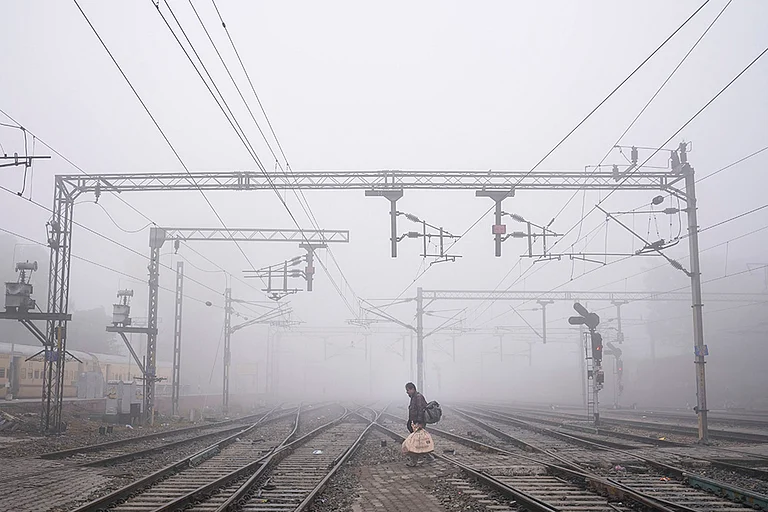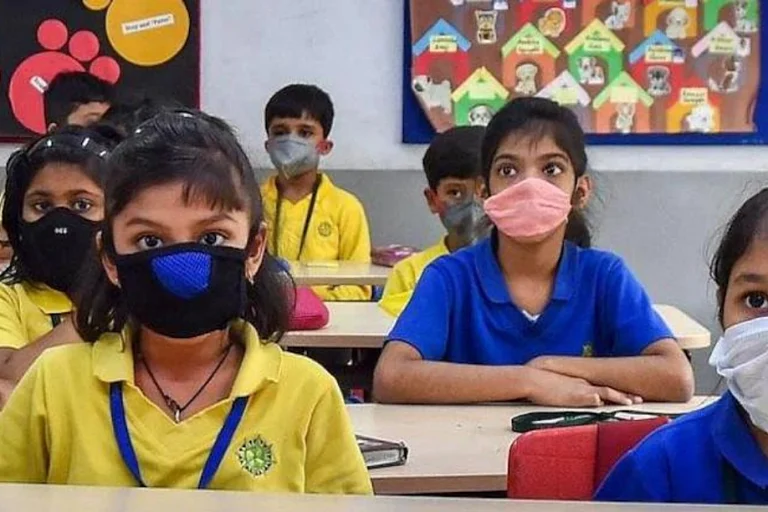HER gaze pierces. Foot placed triumphantly on Mahishasura's neck, she drives her spear through the buffalo demon in a cosmic entrancement of rage. Her large, slanted eyes, the pupils set slightly inwards, hold within them an unspeakable concentration, almost frightening in its intensity. Yet her look is benign; her figure one of exquisite youthful beauty. Bathed in garjan oil—literally, the oil that shouts—she seems afire. Seems alive.
Such is the power of the iconography, a primordial stirring, a sense of the divine grips the witness. Even an agnostic is moved to bow his head.
This is the image of Durga that B.C. Sanyal, the 97-year-old sculptor and painter, remembers from his childhood. An image that incorporates both Durga as Shakti, cosmic destroyer of evil and Durga as Uma, loving mother and daughter returning to her natal home. An image imprinted onto the Bengali collective psyche by artisans from Krishnanagar, Shantipur and Kumartulli since the 19th century, when the worship of Durga as it's known today first made its appearance as a community puja.
Come October, and Bengalis the world over are swept up in an ecstasy of faith. It's time for their annual darshan of Durga. But for years, the powerful image of Sanyal's youth has been missing, overrun in the '80s and '90s by rampant innovation and the incongruous dilutions of popular culture.
Of course, some enclaves of tradition like the pujas in the Kali baris and Durga baris, the pujas at Belurmath and Kalighat to name a few, persisted. But largely, it seemed nothing would stem the worship of Durga—a deity more than two millennia old—from becoming a matinee show.
But this year, for the first time in over two decades, there's a discernible change in mood. Purists and, surprisingly, even people on the street are seeking a move back to the traditional. The odd sketch of Hema Malini, Sridevi or Sharmila Tagore might still have been thrust at idolmakers as prototypes for the Devi's face. Kargil-based pandals and stengun-toting asuras might still have made an occasional appearance, especially in Calcutta. But in the main, the traditional protima dominated. And largely, as actor Victor Banerjee, a self-confessed traditionalist, points out, the pujas this year displayed a palpable return to sobriety.
"It had all gone too far," says artist Samar Datta, one of the judges for the Chittaran-jan Park Mela Ground prize for the best murti in south Delhi. "The Thakur's become secondary. I want to change the trend." The irony's inescapable. Today, competitions like the one Datta judges and the one orga-nised by Asian Paints in Calcutta, stress the traditional. But it was these competitions which, in a sense, sparked off the extravagances of innovation that's mushroomed around, and trivialised, the puja for decades.
Always a joyous religio-social event, over the '80s and '90s, pujas in Calcutta had been reduced to a social jamboree. Deities made of paper, dal, ice-cream sticks, wax, sugar. Pandals built around the fantastic. Cinestars, dinosaurs, the Titanic, Mother Teresa, WWF wrestlers, World Cup Football—any and everything—inserted as backdrops, props, sometimes even as actors in the divine tableau. Psychedelic and laser shows, film music, food stalls, bazaars, coquetry, new clothes. Five days of Bacchanalia. And, of course, faith. That was Durga puja.
"With the prizes, the madness increased," says B. Guha, who judges pan-dals in Calcutta. Ashis Datta, an organiser of the Mela Ground Puja, agrees. In the race to be "radical", as he puts it, the Devi's established iconography was ignored. Whims of technicolour replaced the auspicious red of her sari, the turmeric yellow of her skin and the subtle pith decorations. The single frame which traditionally housed the Devi in a central position with images of Sar-aswati, Lakshmi, Kartik and Ganesh around her—symbolic of her cosmic family and the synergy of divine shaktis out of which she was created—was often disregarded. The riveting gaze of her stylised, slanted eyes gave way to the placid prettiness of celluloid icons or the 'parar may', the girl next door.
SO what caused the change of mood? Salil Bhattacha-rya, a well-known artisan in Delhi, says disgustedly:
"Many of the murtis have become like mere putuls (puppets). The Devi-bhav is completely missing." Adds Prakash Chakraborty, a priest at a Kali bari in Delhi: "Purohits don't even maintain the auspicious timings anymore. Nobody remembers the puja's significance." Too much show. Too many gimmicks. Too much ornamentation. Disenchantment with the glitz of the puja was this year's surprising refrain.
Durga Puja's undeniably a social occasion. But at its heart lies the idea of darshan. The anticipation of the goddess' arrival as she takes up abode in the murti and the spiritual thrill of being held in her gaze. The dissipation of that central experience had to have repercussions. It's for this reason that for many like Sanyal, the goddess' traditional iconography is inviolate. The Devi Mah -atmya, a pivotal Sanskrit text from the fifth and sixth centuries, describes in exacting detail the Devi's "primary form". This has always been incorporated into images of the deity, be it in the sixth or the 20th century. Some may argue that the stylised, trinoy -oni (three-eyed) Durga as she's widely accepted today is itself a product of historical imagination and therefore open to further metamorphosis. But Sanyal disagrees.
"The form has arrived," says he. "You can no longer play with it." But the question persists. If film heroines have greater emotional resonance today, why should the Devi's face not evolve in their wake? Teacher and theatreperson Snehalata Sanyal makes an important point here. "It's not just about popularity but of apprehending the mystery," says she. "The height of any religious experience is the momentary apprehension of the inexplicable—murtis must have that iconic feeling. How can the merely pretty or placid express the powerful myth of the Devi?"
Interestingly, Gaur Kanjilal, a puja committee member in Delhi, confirms this intellectual view in the popular psyche. "We tried to make the Devi look like Hema Mal-ini and Sridevi and come on palanquins," says he, "but fashionable devis are not welcome now. People want the original."
Was this purist backlash inevitable? Not really, for as art critic Gayatri Sinha points out, historically, Durga's lent herself to great plasticity. Since she first appeared as a warrior goddess in Mathura in the first century, she's been worshipped in a thousand guises.
In the Kushan period, for instance, and even in folk art, she doesn't stand triumphantly on Mahishasura. Rather, there's something almost incestuous about the way she's depicted embracing him, even when locked in combat. More recently, a late 19th century image of Durga in Delhi's National Museum has her wielding a revolver, a sign of her co-option into the nationalist movement. In the '30s too, traces of the fair, buxom Armenian bibis of Calcutta—the preferred pin-up girls then—sometimes appeared in murtis. Then again, artists like Madhvi Parekh, Manjit Bawa, Tyeb Mehta and Arpita Singh have painted their own, often playful, interpretations.
Aren't these valid? Why should the Devi's form be canon-ised? First, as artist Bulbul Sha-rma says, there's a difference between the image as art and the image as a spiritual icon which will, in people's eyes, be inhabited by the goddess. For darshan, she's cast in an image which captures the significant mythlogical moment. In Dur-ga's case, it's when intoxicated
with rage and divine elixir, she concentrates all her shakti and places her foot on Mahishasura, preventing him from changing his shape. As she strikes him, order's restored to the world.
More crucially, recent extrapolations are at odds with the protean character of her form. Nawaz Sharif as Mahishasura or Sridevi as Durga are not resonant of the myth. Nor do they seek to further express the heart of the mystery. As art critic Sinha puts it: "Durga might be plastic but the idea of co-opting dinosaurs and the Titanic into the space of the deity is so gross, people were bound to draw a line."
If the protimas of this year are anything to go by, that line has indeed been drawn.






















